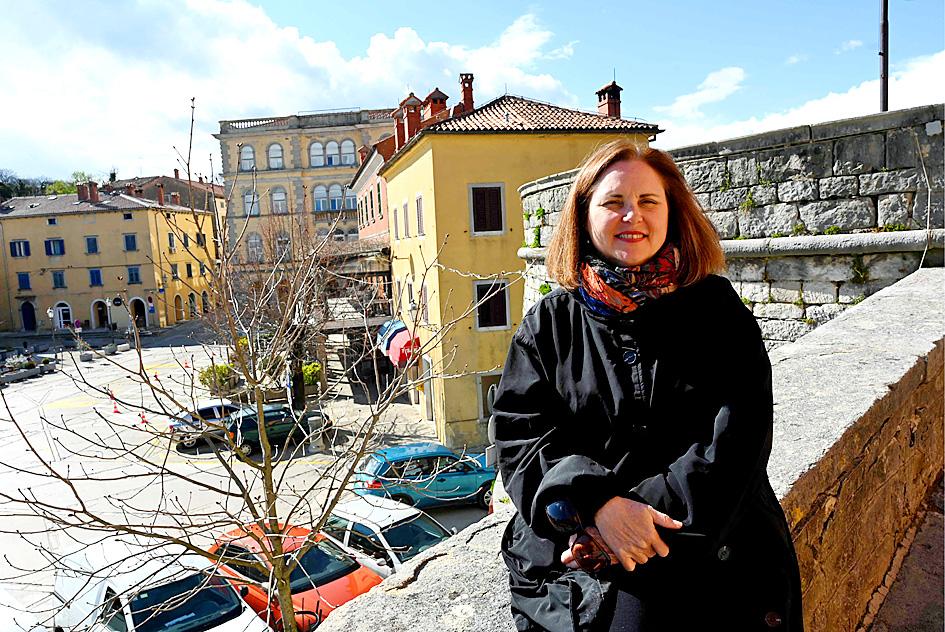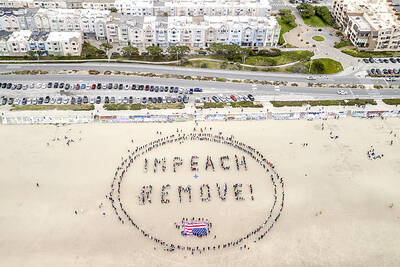Melissa Paul described it as a “beautiful gift” when she became Croatia’s first official digital nomad earlier this year, benefiting from a visa scheme that the country hopes will help promote its travel industry, which has been hit by the COVID-19 pandemic.
“Croatia is gorgeous. It’s beautiful living here, affordable compared with other places, has a great climate, good Internet access,” said the US marketing consultant, who lives among cobblestone streets in Labin, a hilltop town overlooking the Adriatic Sea.
Paul got her visa in January, joining a global army of workers plying their trades in foreign countries since the pandemic ushered in an era of working from home for millions.

Photo: AFP
Croatia offers the special visas to digital workers from outside the EU, allowing them to stay for up to one year and exempting them from income tax.
Applicants need to prove they work remotely, have accommodation and health insurance, and earn at least 2,200 euros (US$2,684) per month.
Paul is one of about 100 people to have applied since the scheme started in January, more than half of them Americans and Britons.
The government has so far approved 33 visas and ministers hope the idea will take off once virus-related travel restrictions are lifted.
Tourism makes up about one-fifth of the economy in the EU nation of 4.2 million people, but the number of visitors plummeted from 21 million in 2019 to 7 million last year.
Income more than halved to 4.8 billion euros last year from in 2019.
The crisis has particularly affected southern areas, such as Dubrovnik, where visitors arrive mostly by airplane.
With the drop-off in tourism, the time was ripe for a fresh idea, and Croatia-based Dutch entrepreneur Jan de Jong was on hand to supply it.
Last year, he used social media to call on Croatian Prime Minister Andrej Plenkovic to introduce the visas — and six months later they became reality.
“Croatia overall, especially in the combination of things, offers a very unique experience,” De Jong said, highlighting the scenery, connections with the rest of Europe and a Mediterranean lifestyle.
However, to be successful with digital nomads, Croatia needed to act quickly and be competitive, he added.
It had rivals in Europe — Estonia launched its nomad visa program last year and countries, including the Czech Republic and Iceland, have similar permits.
Further afield, Antigua is trying its luck and the Indonesian island of Bali has become a major hub.
Trade groups think the idea is going to take off in many more countries.
The Croatian Ministry of Tourism and Sports, which is backing De Jong’s idea, sees it as a long-term opportunity to boost the industry, rather than a quick fix to the pandemic-related crisis.
The ministry said that the digital workers could become Croatia’s best promoters, spreading the word to their peers.
Among the early adopters happy to promote the benefits of Croatia is content creator Steve Tsentserensky, who arrived in the country after years of globetrotting.
Originally from the US, he has spent time in New Zealand, Ukraine, France and Italy, as well as working on cruise liners.
However, he fell in love with the Croatian “pace of life.”
“It’s not like everyone is rushing around,” he said. “You work and you can enjoy your life as well.”
For Melissa Paul, the visa was her last option. She had been living in Croatia since 2014 and was married to a Croatian, but divorce left her with no legal way to remain.
“It allowed me to stay where I love living,” she said.
However, Paul also stresses that foreigners would bring expertise and knowledge that could help the wider community.
This idea is what motivates entrepreneur De Jong, who hopes the influence of foreign digital workers might help young Croatians, many of whom want to leave their own country.
“They would be bringing their mindset and experience and can really have a positive impact on the mindset, mostly of the young generation,” the Dutch father of four said.

POLITICAL PRISONERS VS DEPORTEES: Venezuela’s prosecutor’s office slammed the call by El Salvador’s leader, accusing him of crimes against humanity Salvadoran President Nayib Bukele on Sunday proposed carrying out a prisoner swap with Venezuela, suggesting he would exchange Venezuelan deportees from the US his government has kept imprisoned for what he called “political prisoners” in Venezuela. In a post on X, directed at Venezuelan President Nicolas Maduro, Bukele listed off a number of family members of high-level opposition figures in Venezuela, journalists and activists detained during the South American government’s electoral crackdown last year. “The only reason they are imprisoned is for having opposed you and your electoral fraud,” he wrote to Maduro. “However, I want to propose a humanitarian agreement that

Young women standing idly around a park in Tokyo’s west suggest that a giant statue of Godzilla is not the only attraction for a record number of foreign tourists. Their faces lit by the cold glow of their phones, the women lining Okubo Park are evidence that sex tourism has developed as a dark flipside to the bustling Kabukicho nightlife district. Increasing numbers of foreign men are flocking to the area after seeing videos on social media. One of the women said that the area near Kabukicho, where Godzilla rumbles and belches smoke atop a cinema, has become a “real

Two Belgian teenagers on Tuesday were charged with wildlife piracy after they were found with thousands of ants packed in test tubes in what Kenyan authorities said was part of a trend in trafficking smaller and lesser-known species. Lornoy David and Seppe Lodewijckx, two 19-year-olds who were arrested on April 5 with 5,000 ants at a guest house, appeared distraught during their appearance before a magistrate in Nairobi and were comforted in the courtroom by relatives. They told the magistrate that they were collecting the ants for fun and did not know that it was illegal. In a separate criminal case, Kenyan Dennis

DEMONSTRATIONS: A protester said although she would normally sit back and wait for the next election, she cannot do it this time, adding that ‘we’ve lost too much already’ Thousands of protesters rallied on Saturday in New York, Washington and other cities across the US for a second major round of demonstrations against US President Donald Trump and his hard-line policies. In New York, people gathered outside the city’s main library carrying signs targeting the US president with slogans such as: “No Kings in America” and “Resist Tyranny.” Many took aim at Trump’s deportations of undocumented migrants, chanting: “No ICE [Immigration and Customs Enforcement], no fear, immigrants are welcome here.” In Washington, protesters voiced concern that Trump was threatening long-respected constitutional norms, including the right to due process. The